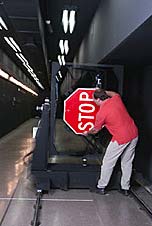
New NIST Facility Soon Will Be ‘Reflecting’ on Safer Signs

Our roadways should get safer in the future, now that the National Institute of Standards and Technology (NIST) has developed a way to accurately and reliably measure how light reflects off stop signs and other road markings.
Road signs and markings are designed to be visible at night by retroreflectivity—that is, they reflect some of the light emitted by a vehicle’s headlights back toward the driver’s eyes. However, measurements of retroreflectivity have varied so much among different devices and laboratories that federal transportation officials have been unable to define minimum standards for this Congressionally mandated characteristic.
Recently, NIST established a facility—funded by the Transportation Research Board of the National Cooperative Research Program—that resolves numerous measurement problems and improves accuracy. Inside the facility, one finds a long black tunnel with a set of tracks on which sits an instrumented platform. Signs or materials are mounted on the platform, which can be moved 3 to 30 meters (10 to 100 feet) from a light source at one end of the tunnel. Using custom software, scientists precisely control all of the components and measure the characteristics of light reflected from the sign to a detector located close to the source.
NIST expects that the facility will begin providing calibration services early in 2004.












